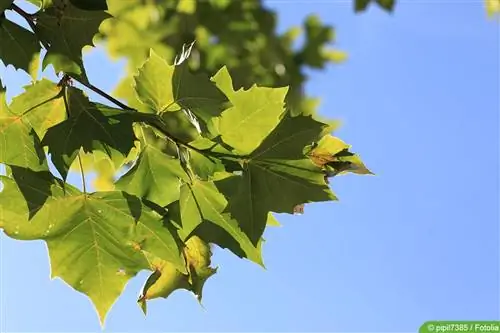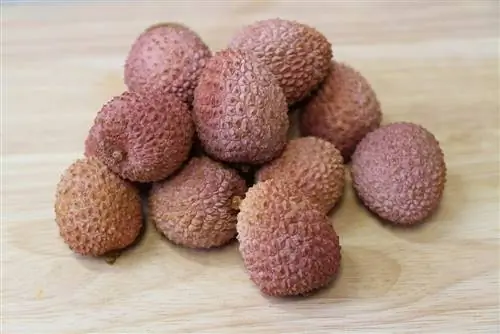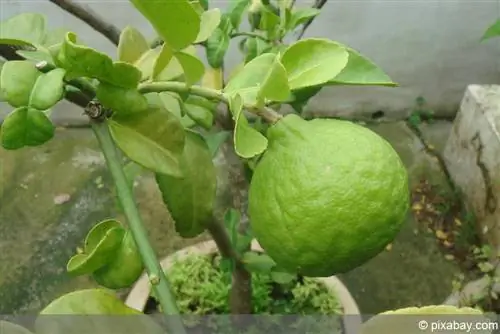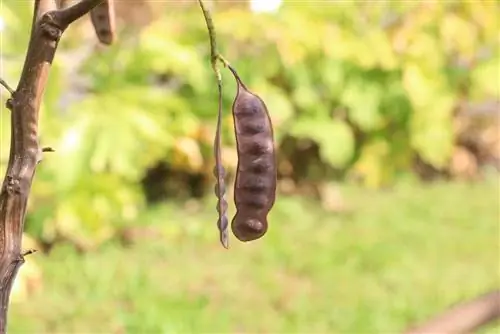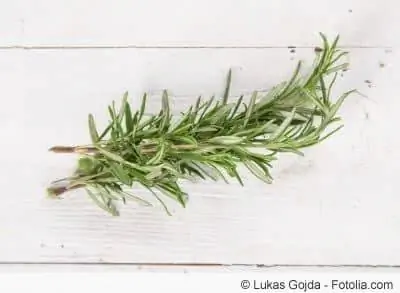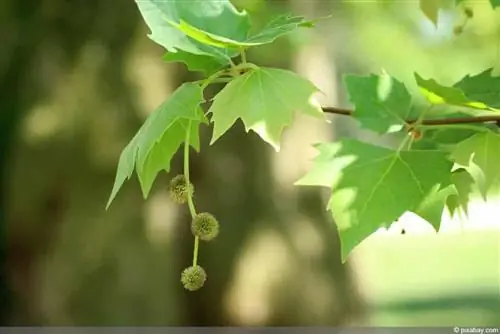- Author admin [email protected].
- Public 2023-12-17 03:39.
- Last modified 2025-06-01 06:48.
Older plane trees are very easy to care for, but as young plants they need attention in various areas in order to grow he althy and grow old. You can read below what proper care looks like.
Profile
- Botanical name: Platanus
- Common names: plane tree, roof plane tree
- Origin: from temperate climate zones in Europe, Asia and North America
- Growth width: 15 to 20 meters
- Growth rate: 45 to 60 centimeters per year
- Growth height: 25 to 30 meters
- Flowering period: April to May
- Flower color: yellowish-green
- Foliage: summer green, colorful autumn leaves, deciduous
- Extremely hardy, young plants sensitive to frost
Location
The basic requirement for a he althy, strong growth of a plane tree is the right location. It should meet the following criteria:
- Lighting conditions: sunny, tolerates partial shade
- Lots of space for tall and wide growth (at least 4.5 meters laterally)
- Protect from the wind if possible (susceptible to branch breakage)
- Mild winter regions
- Ideal for providing shade in parks and private gardens
Soil conditions
In addition to the optimal location, the soil conditions are also responsible for strong growth and defenses. The plane tree draws energy from this through nutrients and trace elements. In order for the supply to work ideally, certain properties of the soil/earth must be taken into account:
- Fresh, deep soil (roots deep as a heart root)
- Preferably loamy and/or sandy if there is sufficient moisture
- Nutrient Rich
- pH value: slightly acidic to alkaline (rich in lime)
- Well permeable to water (avoid waterlogging at all costs)
Best planting time
Plane trees are usually sold in containers. Theoretically, these can be planted all year round. However, spring is the better time, when it starts to warm up and the growing season officially begins. This is because the roots of the new plant are given more time to establish their roots until the coming winter. This will help them get through the cold season better.
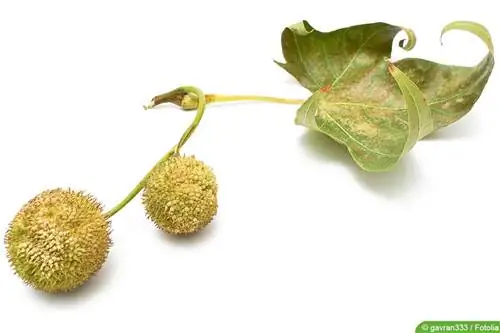
Plant correctly
In order to achieve an ideal establishment of the root system, the correct approach to planting is necessary. This is how it works:
- Dig the planting hole twice as wide as the root ball is
- Choose the depth of the planting hole so that the ball rests and can be covered with soil as high as before in the pot/container
- Enrich the excavated soil with compost
- Insert the plant and fill the planting hole
- Press the soil well
- If necessary, use a stake as a stabilizer (do not connect it with wire or similar - thicker rope or cord is better)
- Lay mulch on the soil surface in the root area - reduces evaporation and slowly releases nutrients
- Water generously and keep slightly moist in the following months (never let the soil dry out)
Pouring
During the first year of planting, a plane tree should be kept slightly moist throughout, without overwatering or even causing waterlogging. From the second year of planting, the roots have established themselves and the water requirement decreases. From now on, plane trees can also tolerate short dry periods. Watering should be regular in midsummer. The younger specimens in particular need more water than the older plane trees because the short roots can absorb less moisture.
Tip:
So-called impact casting is suitable for less work. This involves watering vigorously once instead of administering smaller amounts of water several times. The heart root system and deep roots ensure ideal water storage after burst irrigation. Exception: young plants.
Fertilize
Fertilizing is not absolutely necessary for the plane tree. Thanks to the heart-shaped root spread, the plant reaches other areas of the earth and therefore sufficient nutrients. It is sufficient to mulch every four to six weeks during the growing season. Lawn clippings, for example, are ideal for this. A layer of bark mulch in autumn provides additional protection against the cold and also releases nutrients into the soil through rotting in the following year.
Cutting
Plane trees are very tolerant of pruning. If they are not cut, they grow immensely in height and width. In addition, this will one day lead to expansive crowns that are not considered attractive for everyone. In principle, garden experts recommend pruning. Various cutting techniques can be used:
Conservation and thinning cut
With the maintenance and thinning cut, old and dried branches are cut off. Branches should be removed, especially inside the tree (especially in the crown), if growth that is too dense inhibits air circulation and thereby creates an increased risk of fungal infections. The thinning cut for plane trees is carried out between October and February. It promotes the formation of new shoots and holds crowns together better.
Topiary
In summer, when the flowering is over, the perfect moment has come for a topiary. If you want to own a distinctive roof or ball plane tree, start with the topiary between June and the beginning of August. You should not cut later, as growth slowly slows down from September onwards and there is no “correct” regrowth. If an existing shape needs to be recut, this can also be done during the winter months and can be done together with the thinning cut. It is important to pay attention to the flower buds that have already formed so that they do not fail to bloom in the next flowering season.
NOTE:
When the temperatures slowly drop at the beginning of autumn and the humidity increases, it is important that only dry days are chosen for cutting so that the cuts can dry well. Otherwise there is an increased risk of fungal infestation.
Educational cutting as a roof plane tree
Training cuts known as roof plane trees are very popular. The idea is to cut and “train” branches so that it appears like a flat roof, similar to a parasol. Here's how to do it correctly:
- Remove all vertical shoots
- Short branches that bend downwards where the bend begins
- Short the main branches as much as possible to promote the growth of new shoots
- Cut twice a year: before St. John's Day (June 24th) and again at the end of August
High trunk cut
Plane trees can be further shaped using standard pruning. It works like this:
- Cut off all side shoots on the trunk
- Cut back young shoots before June 24th and at the end of August
- Short main shoots only between October and February (promotes dense crown formation)
Tip:
Cutting causes the leaves to lose their fine hairs. These can trigger an allergy. Therefore, mouth and nose protection should always be worn when cutting.
Wintering

Plane trees are extremely hardy and can tolerate temperatures well below minus 20 degrees Celsius. Only the younger specimens are sensitive to frost in the first three to four years because their roots do not yet extend deep into the earth where frost cannot harm them. They require cold protection layered on the soil surface over the root area. The following are particularly suitable for this:
- Special fleece
- Straw
- Leaves
- brushwood
- pine needles
Propagate
The plane tree is usually a hybrid plant that cannot be propagated from seeds. Therefore, only the cutting method is suitable for propagation. It works easily with the following instructions:
- Best time: Autumn, before cold temperatures cause frost
- Select the optimal shoot: should be at least one-year-old shoot, is slightly woody and between 20 and 30 centimeters long
- Remove leaves and secondary shoots in the lower third of the shoot
- Place the cutting halfway into sandy and nutrient-poor substrate
- Wet slightly and let it “rest”
- Location: bright, cool, but frost-free
- Pull it out of the substrate in March and place it in loosened garden soil (only five centimeters should stick out of the soil)
- Keep soil continuously moist
Tip:
Plane trees are also suitable for cultivation in pots, especially when propagating. Due to the limited space available, they remain in a “manageable” size and can be kept to the desired dimensions by pruning. Just make sure that a deep bucket is available.
Diseases and pests
A plane tree is a very robust and resilient plant. However, diseases or pest infestation cannot be completely ruled out. They can usually be traced back to suboptimal care. Plane trees are most commonly affected by the following
Diseases
-
Tree cancer - triggered by fungal or bacterial infection
Control: remove affected bark and branches over a wide area
-
Massaria disease - fungal disease (Splanchnonema platani)
Combat: not possible
Pests
- Gall mites (Eriophyidae)
- Leaf miners (Gracilariidae)
- Plane tree web bugs (Corythucha ciliata, synonyms: Tingis ciliata, Tingis hyalina)
- Vine mealybugs (Bohemian mealybug Heliococcus bohemicus or maple mealybug Phenacoccus aceris)
Combat
- Make soapy water (dissolve soft or curd soap in water until a cloudy color is formed)
- Add a teaspoon of baking powder per liter of water
- Fill into spray container or pressure gun
- Spray affected plane tree dripping wet
- Repeat every two to three days for around two weeks
- Finally, spray the tree well with clean water to remove baking soda and detergent residues and any pests that are still attached
Plane tree varieties
There are different varieties of plane trees. They do not differ in terms of care, but visually and in their growth they can present themselves differently than the classic plane tree. The most popular varieties include:
‘Tremonia’
- Pyramidal growth
- Growth height: up to 20 meters
'Alphen's Globe'
- Sphere sycamore tree
- Growth height: maximum five meters
‘Suttneri’
- Rare specimen due to special breeding form
- Growth height: up to 20 meters
- Leaves in white, sometimes variegated
- Half-open, wide treetop

